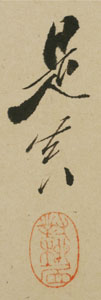Shijô
Crow in snow-covered treeSigned: Zeshin
Seals: Tairyûkyo
Technique: sumi on paper 105,6 x 30,8
Mounting: brown beige damask and light green silk 199 x 34,2
Box: authorized by his pupil Ayaoka Yûshin (1846-1911)
Condition: fine
Zeshin was an important artist. He was very versatile: a good painter, a print designer, a poet, but most of all the finest lacquer artist of the 19th century.
He was born in Edo, in a plebeian neighbourhood near the Ryôgoku Bridge. His father sold bags and pouches. In his youth, age 11, he was apprenticed to the workshop of the lacquerer Koma Kansai II (1766-1835), who was said to be the finest artist of the large Koma family.
As a painterZeshin studied every major Japanese painting style, especially the Shijô style with Suzuki Nanrei (1775-1844) in Edo and with Toyohiko in in Kyoto. For the Ukiyo-e style he was taught by the print designer Kuniyoshi (1797-1861); they share a certain sense of humor in their designs. He studied also the works from the then recently deceased Rimpa artist Sakai Hôitsu (1761-1828) and his followers. In Kyoto he stayed with Toyohiko, where he also met with the circle around Rai San’yô (# 57).
In 1832 he received his name Zeshin from Nanrei and build him self a studio looking out on a grove of willow trees and called it "Tairyûkyo": willow-facing residence. In 1835 he succeeded Koma Kansai II as the head of the Koma School. To represent and advertise Japan in the West his paintings were send to the Vienna international exhibition in 1873 and to Philadelphia in 1876.
Reference:
next to a lot of monographs like
Link 1979
Izzard 2007
briefly in
Roberts p. 209
Araki p. 1459-1461
Rosenfield '99, B.82
Price: SOLD

